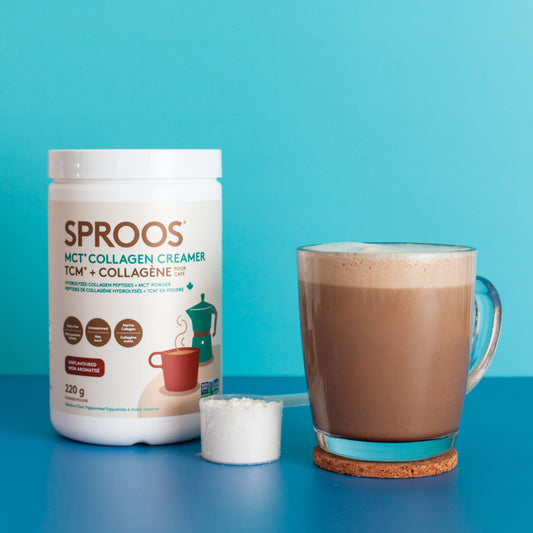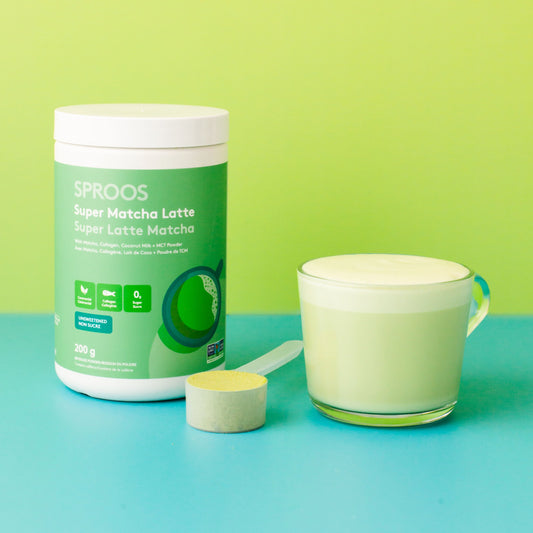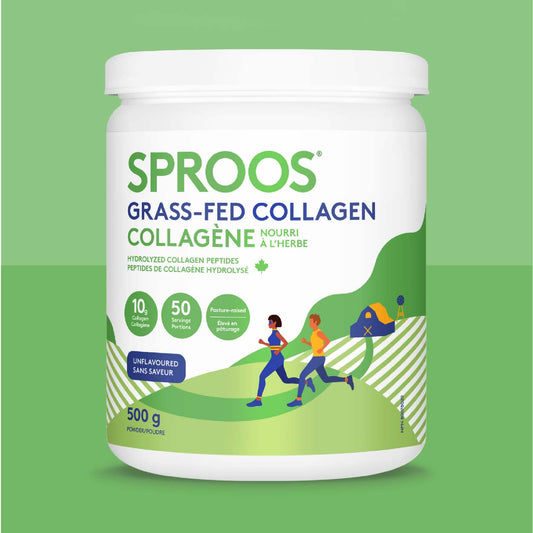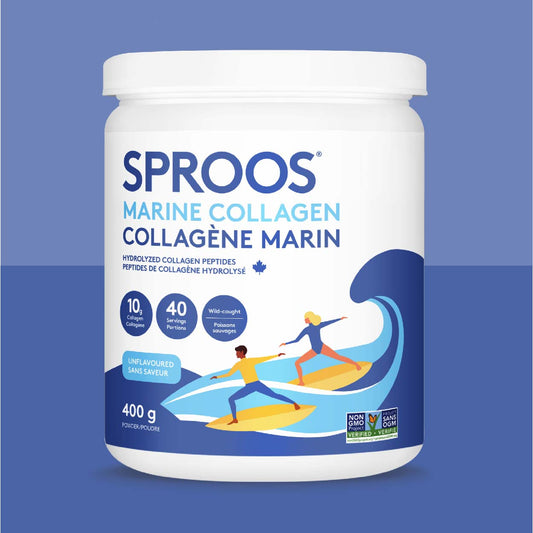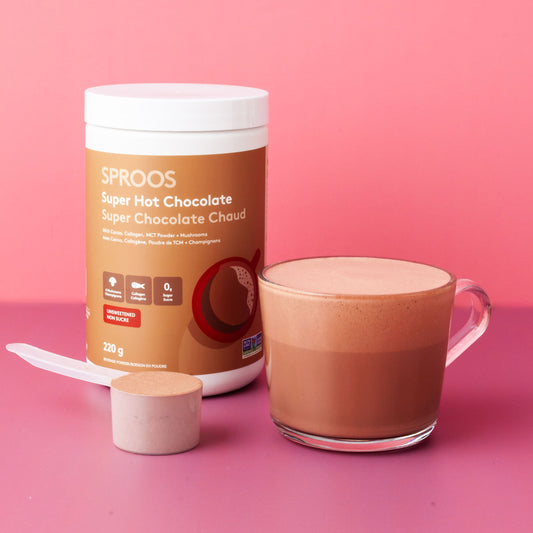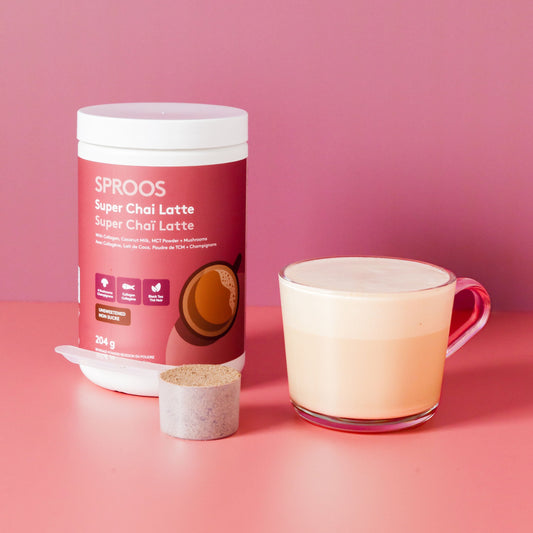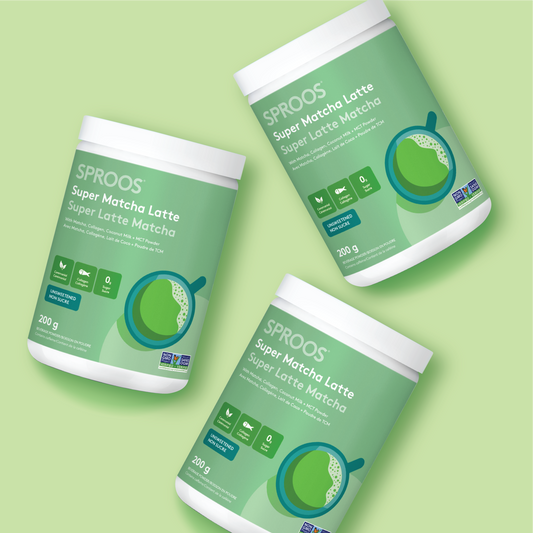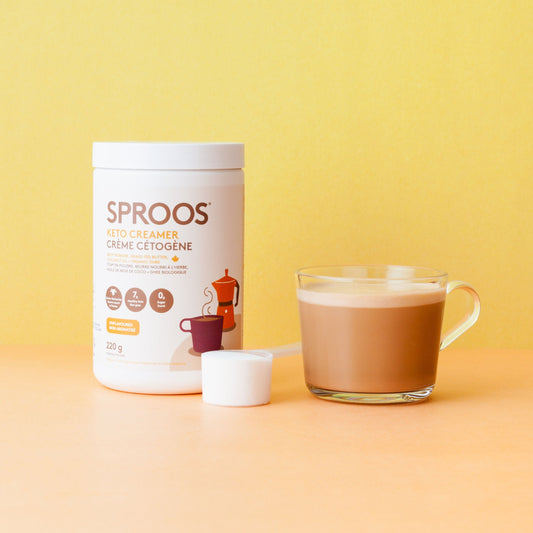Greens plus collagen? There’s only one product on the market that does that! Our Collagen Greens combines our wild-caught marine collagen with a carefully chosen blend of five micronutrient-rich organic greens. This product contains a source of vitamin C – organic acerola – to help with absorption. Lastly, there’s coconut water and sea salt for electrolytes and hint of flavour! This is a superstar of a product, and a unique one at that. Here are some of the benefits of each of the ingredients that were purposefully chosen for this product.
MARINE COLLAGEN
Each scoop of our Collagen Greens contains 7 grams of wild-caught marine collagen. We’ve talked plenty about the benefits of marine collagen, but here’s a refresher: Marine collagen is made up of type I collagen which is the most abundant type of collagen in the body. Type I collagen is found in the skin, teeth, bones, ligaments and connective tissue. Because of this, collagen can help improve overall health and well-being!
Supplementing collagen into your daily routine can help improve the appearance of skin, support joint health and improve bone structure and strength. Collagen can also help with recovery from injury or physical activity and even support gut health.
ORGANIC GREENS
There are 6 grams of organic greens per scoop.
1. WHEATGRASS
Wheatgrass is the young grass of the wheat plant. It has a high chlorophyll content (makes up 70% of its chemical constituents!) as well as a variety of other vitamins and minerals. In addition, it is a rich source of vitamin A, C, E and B and has minerals including calcium, phosphorus, magnesium, potassium and zinc. Talk about a powerhouse of a plant!
Wheatgrass is known for its high levels of chlorophyll, a compound that has shown to support health and well-being. Chlorophyll is what makes plants green, hence why wheatgrass is bright, bright green! Although there have been limited studies investigating the health benefits of chlorophyll in humans, much has been researched in labs. Chlorophyll has shown to have strong antioxidant activity. Antioxidants are molecules that help neutralize “bad” molecules in the body called reactive oxygen species or ROS. ROS accumulate in our bodies from everyday activities, so it is important to include antioxidant foods or supplements in our diets.
Interestingly, chlorophyll has a similar chemical structure to hemoglobin. Hemoglobin is a protein in your red blood cells that carry oxygen to various organs and tissues. Because of the similarity in structure between chlorophyll and hemoglobin, there is research suggesting that there is the potential for chlorophyll to help people with diseases of the blood. This includes illnesses such as anemia. However, much research still needs to be conducted before any conclusions can be made in this area.
2. SPINACH
Leafy green vegetables are known for having health promoting properties, and spinach is no exception. Spinach is rich in magnesium, potassium and iron as well as vitamin A, C and K. Spinach is also high in fiber. Fiber is a carbohydrate that the body cannot digest. Because of this, fiber is excellent at promoting the feeling of fullness, regulate sugar levels in the body and promotes normal bowel movement.
In addition to being a good source of various vitamins and minerals, spinach is also a good source of phytochemicals. Although the word sounds a little scary, phytochemicals are actually incredible molecules that provide a lot of health benefits and can reduce the risk of major chronic diseases. In the case of spinach, the subtype of phytochemicals that it contains are polyphenols. Polyphenols have excellent antioxidant activity, similar to that found in wheatgrass.
3. KALE
Kale is a very nutrient-dense vegetable. It contains calcium, folate, riboflavin, magnesium and iron to name a few, as well as plenty of vitamins (vitamin A, B1, B2, B6, C and E). In fact, kale is actually a great source of calcium!
In traditional medicine, kale has been used for its benefits to the gastrointestinal tract. Kale has shown anti-ulcer activity and has been used to help decrease the symptoms of inflammatory bowel disease. Despite its uses in traditional medicine, more high-quality research needs to be conducted before any conclusions can be made regarding kale for digestive and intestinal issues.
As mentioned previously, there are a class of compounds found in plants called phytochemicals. These are also present in kale. Some of these phytochemicals found in kale have actually been found to help the cardiovascular system (read: heart and blood vessels). Certain phytochemicals as well as vitamin E and C are all components of foods that have been associated with cardiovascular protection and a decrease of cardiovascular disease risk.
4. SPIRULINA
Believe it or not, spirulina is a microalga. What?! Microalgae are tiny, single-celled organisms that live in saltwater and freshwater. It is actually impossible to see a single microalga, that’s how small they are. Spirulina is rich in protein, vitamin and minerals and has been consumed for its health benefits for thousands of years.
The research that has been conducted on the benefits of spirulina are far-ranging. Spirulina has been shown to have strong antioxidant and anti-inflammatory benefits. Pre-clinical studies show that spirulina could potentially help reduce cold and flu incidence and symptoms. This is through stimulating the immune system and as an anti-viral agent. Supplementing spirulina has also shown to have cardiovascular benefits. Some of the benefits documented include decreased blood pressure and lowered blood lipid and cholesterol levels.
5. MORINGA
Moringa comes from the moringa tree which is native to India and surrounding countries. It is a super nutrient-dense green containing a bunch of vitamins and minerals. Moringa has been eaten for thousands and thousands of years. It was originally used for mental alertness and healthy skin. Since then, more research has found that the plant has many more benefits beyond that! Moringa has helped relieve vitamin and mineral deficiencies, support the cardiovascular system, promote normal blood glucose levels, support the immune system and more. It really is an incredible plant!
HOW DO I USE COLLAGEN GREENS?
Great question! Collagen Greens was designed as a stand-alone product that could be consumed by itself. For this reason, we recommend adding one scoop to a cup followed by at least 355-473 mL of cold water (or coconut water). Shake, blend or whisk well until fully combined. We like to add a squeeze of lemon or lime for an extra zing!
If drinking green juice isn’t really your thing, add a scoop of our Collagen Greens to your favourite smoothie. We’ve got plenty of smoothie recipes (keto smoothie, tropical smoothie and green smoothie)here on our blog that you can check out for inspiration! Collagen Greens can also be used in other recipes such as on popcorn, in sauces or in baking.
SOURCES
- Bar-Sela, G., Cohen, M., Ben-Arye, E., & Epelbaum, R. (n.d.). The Medical Use of Wheatgrass: Review of the Gap Between Basic and Clinical Applications. Mini-Reviews in Medicinal Chemistry, 15(12), 1002–1010.
- Capelli, B., & Cysewski, G. R. (2010). Potential health benefits of spirulina microalgae*: A review of the existing literature. Nutrafoods, 9(2), 19–26.
- Padalia, S., Drabu, S., Raheja, I., Gupta, A., & Dhamija, M. (2010). Multitude potential of wheatgrass juice (Green Blood): An overview. Chronicles of Young Scientists, 6.
- Roberts, J. L., & Moreau, R. (2016). Functional properties of spinach (Spinacia oleracea L.) phytochemicals and bioactives. Food & Function, 7(8), 3337–3353.
- Šamec, D., Urlić, B., & Salopek-Sondi, B. (2019). Kale (Brassica oleracea var. acephala) as a superfood: Review of the scientific evidence behind the statement. Critical Reviews in Food Science and Nutrition, 59(15), 2411–2422.
- Solymosi, K., & Mysliwa-Kurdziel, B. (2017). Chlorophylls and their Derivatives Used in Food Industry and Medicine. Mini Reviews in Medicinal Chemistry, 17(13), 1194–1222.


